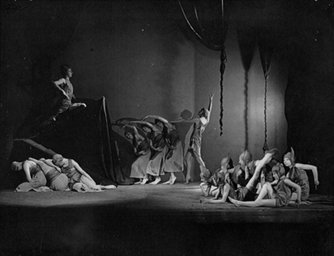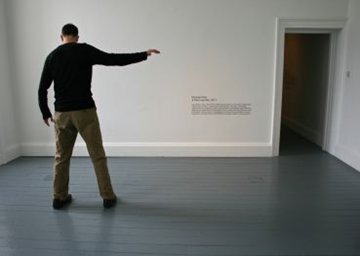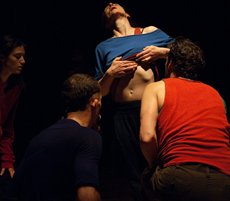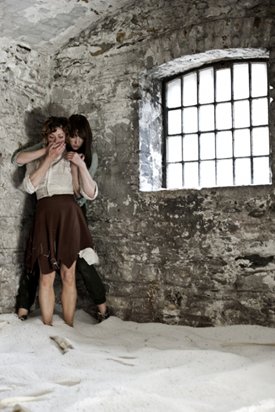Much of what happened in dance during 2011 gave hope for the future. But some of what happened gave fear for the past. Emerging choreographers came of age, organisations celebrated anniversaries and new developments countered the bleakness caused by growing unemployment, emigration and general social pessimism. But the demise of Daghdha Dance Company, coupled with the prevailing belt-tightening austerity, brought us back to the recessionary 1980s, when the Arts Council axed a national ballet and contemporary dance company. Some impressive choreography made its way onstage over the past twelve months, but the loss of the Limerick-based company was the most significant dance event of the year.
Daghdha had a slower death than Irish National Ballet and Dublin Contemporary Dance Theatre in 1989: its funding went from €525,000 in 2007 to zero in 2011. In addition the Arts Council valued its “strong artistic production and impressive development programmes” in 2007, but three years later was suggesting that the company might jettison that programme and evolve into a new graduate performing company that the Council was setting up with the University of Limerick. And by 2010 the Council was intervening in Daghdha's artistic programme, by offering funding that hadn't been requested, reasoning that “although the Council normally prefers to engage with and fund organisations on the basis of what they propose, in this case it will be necessary for the Council to specify those elements of the company's programme it wishes to support.”
Why did the Council change its attitude to Daghdha? Difficult to say. In that period there was no major shift in the company's artistic direction, no controversial new appointments or financial scandal. The full story has yet to be told and the Ccouncil have never released a statement explaining its decision, but the loss of Daghdha's 23-year artistic presence in Limerick and the €3million the Council invested in the company since 2003 cast a shadow throughout this year.
As Daghdha disappeared, the graduate performing company, Step-Up, was established during the summer at the Irish World Academy of Music and Dance at the University of Limerick in conjunction with Dance Ireland. The initial pilot programme involved six dancers working with choreographers Charles Linehan and Cork-native New York-based Luke Murphy, presenting a showcase in Limerick and DanceHouse in Dublin. Managed by Jenny Roche it seeks to address the perennial problem of emigrating dancers, by offering a performance outlet for graduates.
Also at the University of Limerick, the National Dance Archive was launched by Dance Research Forum Ireland. Over forty individuals, companies and organisations from all dance-forms have donated over 5,000 print and audio-visual materials spanning a period of over 100 years, providing an important step towards promoting Irish dance history, and gaining a sense of perspective in assessing current work.
 Victoria O'Brien is the archive's Development Officer and her book A History of Irish Ballet from 1927 to 1963, published this year, uncovered some hidden histories. Probably the most significant contribution to Irish dance scholarship yet, O'Brien painstakingly researched ballet dancers and choreographers that were effectively written out of history through shoddy investigation by historian heavyweights like Katherine Sorley Walker. The achievements of unsung heroines like Cepta Cullen, Muriel Kelly, Patricia Ryan and Sara Payne were unearthed and filled in the gap in lineage from De Valois at the Abbey Theatre in the 1920s to Joan Denise Moriarty in the 1960s.
Victoria O'Brien is the archive's Development Officer and her book A History of Irish Ballet from 1927 to 1963, published this year, uncovered some hidden histories. Probably the most significant contribution to Irish dance scholarship yet, O'Brien painstakingly researched ballet dancers and choreographers that were effectively written out of history through shoddy investigation by historian heavyweights like Katherine Sorley Walker. The achievements of unsung heroines like Cepta Cullen, Muriel Kelly, Patricia Ryan and Sara Payne were unearthed and filled in the gap in lineage from De Valois at the Abbey Theatre in the 1920s to Joan Denise Moriarty in the 1960s.
Most controversially, O'Brien claims that Moriarty fuelled the ignorance in ballet's history by failing to acknowledge her predecessor's achievements. Throughout her career she claimed that Ireland had no tradition in ballet and that she was a pioneer, staging Irish premieres of standard repertoire. The Arts Council also received veiled criticism for attempting to fuse Moriarty's Cork-based Irish Theatre Ballet and Patricia Ryan’s Dublin-based National Ballet School and Company, into one Dublin-based company. That company lasted barely a year, causing Ryan to emigrate and Moriarty to perpetuate her pioneer status.
 Elsewhere this year, close links between politics and dance came to the fore with Michael Klien's diptych A Silent Witness – The Dancing Man at IMMA. For Silent Witness he spent time in the Dail observing the daily structures, interactions and how it organises itself, as well as shadowing Minister of State for Trade and Development Jan O'Sullivan in her constituency work. Klien's choreographic response to this took place in a gallery in IMMA where he danced solo for six hours a day. The resulting performance was a both polemic and meditation, and was always thought-provoking and elegantly articulate.
Elsewhere this year, close links between politics and dance came to the fore with Michael Klien's diptych A Silent Witness – The Dancing Man at IMMA. For Silent Witness he spent time in the Dail observing the daily structures, interactions and how it organises itself, as well as shadowing Minister of State for Trade and Development Jan O'Sullivan in her constituency work. Klien's choreographic response to this took place in a gallery in IMMA where he danced solo for six hours a day. The resulting performance was a both polemic and meditation, and was always thought-provoking and elegantly articulate.
A more general re-examination of post-boom society was undertaken by both David Bolger and Michael Keegan Dolan. Keegan Dolan's Rian drove opinion to extremes, between those who considered its choreography featherweight and its execution self-satisfied, and those who rejoiced in its self-confidence and simplicity. There was more consensus about David Bolger's Touch Me for CoisCéim Dance Theatre, which returned to De Valera's “The Ireland that we dream about...” speech. Bolger had mercilessly sent it up in his bullish 1995 dance Reel Look, but in Touch Me there is less sneering and more considered reflection over the Ireland we now dream about, particular with President O'Higgins' call for active citizenship fresh in the memory. Bolger's steady choreographic hand skilfully managed the material into a coherent whole without being prescriptive and allowed important ambiguity to linger about austerity versus abundance.
 It's a trait evident in the work of many independent choreographers, who are confident to allow multiple layers of meaning and truth to emerge simultaneously in their work. “I'd rather let the dancers embody something that allows people to think rather than just passively receive,” said choreographer Fearghus O Conchuir in an interview with The Irish Times. His Tabernacle, premiered at the Dublin Dance Festival and repeated at Kilkenny Arts Festival, was deliberately ambiguous in its avoidance of religious imagery and direct comment on clerical sexual abuse.
It's a trait evident in the work of many independent choreographers, who are confident to allow multiple layers of meaning and truth to emerge simultaneously in their work. “I'd rather let the dancers embody something that allows people to think rather than just passively receive,” said choreographer Fearghus O Conchuir in an interview with The Irish Times. His Tabernacle, premiered at the Dublin Dance Festival and repeated at Kilkenny Arts Festival, was deliberately ambiguous in its avoidance of religious imagery and direct comment on clerical sexual abuse.
 During the Absolut Fringe Festival, junk ensemble's Bird With Boy was a sprawling dance installation that constantly starved the audience of resolution with its exploration of incompleteness and finality. It was brilliantly executed, but although Jessica and Megan Kennedy found richly atmospheric pickings in the cold, damp gloom of Kilmainham Gaol, the dank surroundings also stripped away any trace of levity, normally found bubbling under their choreography.
During the Absolut Fringe Festival, junk ensemble's Bird With Boy was a sprawling dance installation that constantly starved the audience of resolution with its exploration of incompleteness and finality. It was brilliantly executed, but although Jessica and Megan Kennedy found richly atmospheric pickings in the cold, damp gloom of Kilmainham Gaol, the dank surroundings also stripped away any trace of levity, normally found bubbling under their choreography.
Dance duo Fitzgerald and Stapleton's success in New York was matched at home with The Smell Of Want, a satisfyingly obtuse dance about the unattainable, while in Solo Logic the Tipperary-based Iseli-Chiodi Dance Company featured Alexandre Iseli searching for truth in movement. To a video backdrop, his body seemed to move in a simultaneous act of purging ingrained habits and re-learning movement from the inside out. It was an impressively constructed and performed with unaffected honesty. In John Scott's Actions, Antonio Trinidad and Philip Connaughton were found similarly in search of a dance, but punctuated their explorations with spoken directions and witty asides to the audience.
Much of ever-strengthening independent dance scene is percolating from DanceHouse in Dublin, which celebrated its 5th birthday this year. Its inclusiveness has allowed individual aesthetics to flourish and dialogue to start in public talks and workshops, as diehard Deborah Hay practitioners find themselves rubbing shoulders with a salsa class, or members of Ballet Ireland with a dance group for the elderly.
There were comings and goings this year, including the sad death of Ursula Laeubli, co-founder of Echo Echo Dance Company in Derry, at the age of 46 following a long battle with cancer. Laurie Uprichard programmed her final Dublin Dance Festival with a fascinating range of Asian artists, and Julia Carruthers was appointed as new artistic director.
The festival, ten years old next year, is now a steady fixture in the dance landscape, but underneath the infrastructure it has helped to created, along with DanceHouse and others, is an impermanence that was illustrated in the circumstances that led to the demise of Daghdha. Artists have always been challenged in describing their art in the language of tick-boxes and mission statements. But a climate of austerity often leads to a culture of justification in the arts. Maintaining artistic sovereignty might get trickier in future years, but much of the choreography witnessed in 2011 had a confidence and sure-footedness that will stand it in good stead.
Michael Seaver is dance critic with The Irish Times